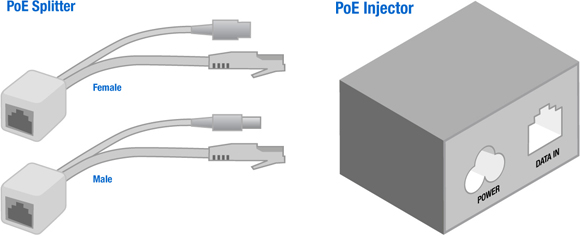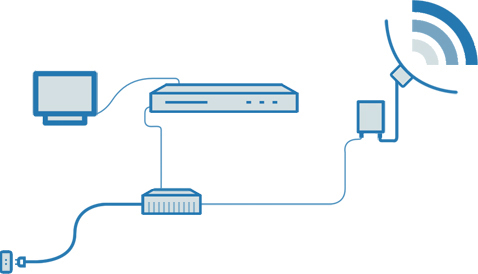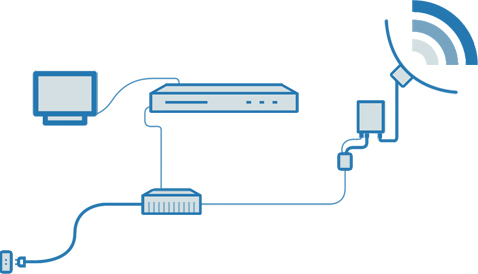Power over Ethernet (PoE) Guide
Introduction to Power over Ethernet (PoE)
The need to power Wireless Networking devices in areas where mains power supply is not available or is not practical is a very limiting factor in the deployment of a wireless network. This is because many devices such as Access Points, Bridges, Routers, VoIP phones, IP CCTV cameras etc. are normally limited to having a mains AC power supply near to the DC adaptor. If the device has a built in transformer this would normally mean you would have to run a mains extension cable all the way to the device, which is not safe.
After the need to power remote devices became apparent, the IEEE developed a standard called 802.3af which was a system that provided low voltage power to devices via the use of a CAT-5 Ethernet cable, more commonly known as Power over Ethernet or PoE. This gives the added benefits of increased mobility for the location of the end devices, better safety as no AC mains power supply is involved in a significant way, the reliability of managing the activity of devices more easily in power outages and the decrease in installation costs.
With regard to outdoor wireless networks, Power over Ethernet (PoE) can be very useful when the Wireless Networking device, such as an Access Point or Bridge, needs to be close to an antenna because of the required short Co-Axial cable lengths. The power supply can be run over Ethernet cable up to 100m, without significant loss, from the injector up to the device without any mains power involvement.
How Power over Ethernet (PoE) Works
Put simply, Power over Ethernet (PoE) works by converting mains power supply into a low voltage supply that is sent down the two (usually) spare pairs of wires inside the CAT-5 cabling to power the end device. In the Power over Ethernet (PoE) system, there are two at least two units involved:
- PSE (Power Sourcing Equipment): These take the mains power supply and provide the low voltage, DC electrical supply down the Ethernet cable. PSEs can supply up to, around, 12 Watts at 48 Volts to a Power over Ethernet (PoE) compatible device requiring power. In Wireless Networking there are two types of PSEs known as Endspans and Midspans. Endspans work in the same way as Ethernet switches that also include the power supply over the Ethernet data transmission circuit. Endspans can be referred to as Power over Ethernet (PoE) switches. Midspans are power injectors that are located in between a regular Ethernet switch and the powered device whilst injecting power without affecting the data. Midspans can be referred to as Power over Ethernet (PoE) Injectors.
- PD (Powered Devices): These are the Power over Ethernet (PoE) enabled devices at the end of the Ethernet cable that require low voltage, DC power. In Wireless Networking the PD may have an integrated Power over Ethernet (PoE) Splitter that will split the power supply and data supply and source them to the relevant areas, however, if a device doesnt, a Power over Ethernet (PoE) Splitter must be used before the PD with a DC cable running from the Power over Ethernet (PoE) Splitter to the device along with another Ethernet cable.

There are two ways of providing the power over the cable and are known as Alternative A and Alternative B.
- Alternative A: This uses a method called simplex or phantom feeding which carries the power on the same cables as the data. The PSEs superimpose the power feed onto the data feed pins through the centre tap of the internal signal coupling transformers.
- Alternative B: This uses a method whereby the power supply is carried over the two spare pairs of wires in the Ethernet cable.
Power over Ethernet (PoE) Powered Devices are designed to be compatible with either Alternative A or B up to around 48V and the use of Ethernet cable allows 1Gbps data rates.
When a Power over Ethernet (PoE) device is turned on, the PSE is designed to detect how much power the PD requires and supply it with only the necessary amount. This is done by using a class system which denotes the amount of wattage to send to the device.
Class |
Power (W) |
Class Description |
Application |
| 0 |
0.44 - 12.94 |
Class Not Specified |
Not Specified |
| 1 |
0.44 - 3.84 |
Very Low Power |
VoIP Phone |
| 2 |
3.84 - 6.49 |
Low Power |
IP Camera |
| 3 |
6.49 - 12.95 |
Mid Power |
Wireless Networking Device |
| Class 4 can only be used by new IEEE 802.3at (Power over Ethernet (PoE) Plus) devices |
| 4 |
12.95 - 25.50 |
High Power |
High Power Wireless Networking Device |
By using this technique electricity power is not wasted on devices that do not require the whole supply and devices should not be damaged by over powering.
Application Examples
Application 1:

The above diagram shows a Power over Ethernet (PoE) injector taking in an Ethernet cable from a computer connected to the LAN, in this instance via an Ethernet Switch, and sending out the data and power supply over another Ethernet cable to the Wireless Networking device. In this case, the Access Point has an integrated splitter so the Ethernet cable can be plugged straight into the AP; this may sometimes be referred to as built-in Power over Ethernet (PoE) capability.
Application 2:

In this next example, the AP does not have a built in splitter or is not compatible with Power over Ethernet (PoE). A Power over Ethernet (PoE) Splitter must be used before the Wireless Networking device to separate the power and data supplies and route them individually using another Ethernet cable and a short DC power lead. Splitters often have the feature to drop the voltage from a 48V supply to the voltage required by a device i.e. 12V.
Fully 802.3af compliant devices have smart power management built in to protect them from becoming damaged by Power over Ethernet (PoE) power supply. They ensure that only the maximum power levels are supplied from the PSE through the class system, devices shut down when the power supply is stopped and that any problems cause the device to shut down or restart depending on the error.
Power over Ethernet Plus (PoE +)
As of 2009 a new IEEE standard, known as 802.3at or Power over Ethernet (PoE) Plus, was created that allows a maximum power supply of 25.5W. This allows devices to operate at much higher power levels or can allow a single Power over Ethernet (PoE) Switch to power more devices simultaneously.